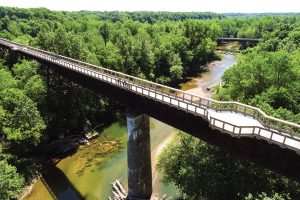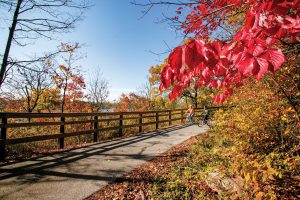As a former lieutenant governor, Sheila Simon has seen a lot of Illinois – through a windshield, from the air and even onboard passenger trains. But Simon’s favorite way to appreciate the state is perched on two wheels. Simply put, Simon is an avid bicyclist.
“There are just so many beautiful parts of the state and so many beautiful discoveries. I’ve driven around the state a lot, but every time my family explores on our bike rides, I discover more things that I haven’t seen before, beauty that I did not know existed,” she says.
Simon says Illinois has something to offer all types of bicyclists. “There are just so many opportunities for bikes,” Simon says. “If you’re not excited about biking on a road, there are miles and miles of trails throughout the state, there are mountain bike-specific trails and there are places with bicycle lanes, but generally, the roads are wide enough for bicycles, too.”

Simply put, Illinois is in almost any bicyclist’s wheelhouse. From mountain biking to racing and leisurely recreational rides to cross-country tours, all genres of cycling can be found across the state. Illinois has dozens of bicycle clubs, and the League of American Bicyclists has designated nearly 20 Illinois cities as “Bicycle Friendly Communities,” including Carbondale, Champaign, DeKalb, Normal, Springfield, Urbana, Washington and many Chicagoland area municipalities.
Bicycles are rolling into the forefront not only for recreation but also as a form of transportation, thanks to higher fuel prices and a renewed focus on bicycle lanes, “complete street” programs and efforts of advocacy groups, cities and state government agencies.
The state is home to dozens of off-road trails designed exclusively for mountain bikes, complete with rocks, limbs and other obstacles and challenges for riders to negotiate. For those preferring paved roads, organized rides and tours happen across the state practically every weekend, and two national coast-to-coast routes cross through Illinois: The TransAmerica Trail (originally called the Bikecentennial Trail) was established in the 1970s and runs through the southern part of the state from Chester to Elizabethtown. The other, the Grand American Rail-Trail, now under development, utilizes multi-use paths and trails spanning from the Quad Cities to just south of Chicago.
Bicycle trails
Trails and paths, developed specifically for use by bicycles, runners and pedestrians, are growing in number and popularity across Illinois. Some are paved; others feature crushed stone riding surfaces. Many have been converted from railroad beds, offering riders sweeping curves and gentle slopes. Novice cyclists seem to love the trails because of the lack of motorized traffic, but many seasoned riders prefer trails, too.
Oswego’s Mike Bentley remembers growing up on a bicycle. “I went everywhere on my bike,” the 62-year-old recalls. “We all lived on our bikes as kids because moms and dads didn’t take you anywhere back then.”
He said he fell in love with bicycling as a teen, riding the bicycle routes in Downers Grove and nearby trails with friends. He says he’s not stopped pedaling since and rides almost daily, still taking advantage of the network of trails in his region.
“The Fox River Trail is just about 100 yards from my house. I jump on that and take it up to the Gilman Trail, which runs out to Waubonsee Community College and back. It’s about 26 miles – the perfect ride. I like the trails,” he says, adding that he has ridden trails throughout much of Illinois and has plans to pedal on those he hasn’t tried yet.
Many of the trails in the northern part of the state interconnect, making longer tours possible. There are visions of connecting other trails to one another, making for an even larger network, perhaps some of which will reach across the state.
“We’ve got to fill in those gaps to have a continuous network across Illinois,” says Dave Simmons, executive director of Ride Illinois, a statewide advocacy group for bicycles as recreation and transportation. “That’s something we’ve been working on and it would really be a great destination for people. Some people don’t want to ride just five miles, they want to ride across the state.”

Photo courtesy of the Illinois Department of Natural Resources.
One such linked trail is the Grand Illinois Trail, a 500-plus-mile loop across the state from Chicago westward to East Moline, then north to Galena and then eastward back to Chicago’s Navy Pier. About 200 miles of the route is on paved roads with the remainder on paths or limestone trails.
Other networks of connected trails – just not as long – can be found in other parts of the state, too, as can many “stand-alone” trails such as the Madison County Transit Nickel Plate Trail in southwestern Illinois, the Rock Island Trail in Peoria and Stark Counties, the Tunnel Hill Trail in southeastern Illinois, the Constitution Trail through Bloomington-Normal and the 104-mile Hennepin Canal Parkway in Bureau, Henry and Whiteside Counties.
Simmons says trails – and the expansion of trails – present a great opportunity for communities. “Riders on these trails need calories, they need beverages and other things to do,” he explains. “Without the trails and the connections between trails, towns are missing out on revenues.”
He cautions, however, that trails require money for construction, upgrades and maintenance. “We’d like to see more funding to promote and maintain these trails.”
That’s one area his group is working on – additional funding for bicycle-related projects throughout the state. He says promotion of bicycle activities can be a key in drawing visitors from other states. “In our opinion, it needs to be a focus from a tourism angle, and it’s one of those chicken-and-egg things. Do you get the funding that brings the tourists or does the funding come after the tourists? I think it has to be a multi-faceted approach to get people to think of Illinois as a destination when it comes to biking,” he says.
Riders like Bentley appreciate the trails and the focus that organizations and the state are giving to them. “The trail systems are good and Ride Illinois is big with pursuing towns to get bike routes and to clean up and maintain trails,” Bentley says. “Plus, there are a lot of places putting in bike-safe lanes. It’s all really improved over the last 20 or 30 years.”
Pedaling together
Simmons says the mission of Ride Illinois simply is to make Illinois better through biking. He explains it does that by educating riders and drivers as well as by lobbying and pushing for more people to take up riding and do so safely.
Bikes also have become a primary focus for both the Illinois Department of Natural Resources – which overseas a majority of trails across the state – and the Illinois Department of Transportation.
“Since the late 1990s and early 2000s, we have tried to create a statewide network of trails, on-road and off-road greenways and bikeways by partnering with counties or multiple county areas,” explains Amy Madigan of the Illinois Department of Natural Resources. She says bicycles are a perfect fit for the department. “Often, bicycle trails are a great way without a lot of space to create some transportation corridors and recreation corridors. We’re both just trying to open up new means of recreation and transportation, and, in many cases, linking communities for non-motorized traffic.”
In the case of IDOT, that focus has put more resources into bicycle transportation in recent years. Complete streets legislation requires that the department consider all roadway users – not just cars, trucks, motorcycles and buses – but also pedestrians and bicyclists in roadway construction and design.

“Sometimes it’s just an improvement of current accommodations for bicycles; other times it is the creation of protected lanes separate from the roadway; other times they are bicycle lanes,” explains Lee Ann Prather, bicycle/pedestrian coordinator for the Illinois Department of Transportation’s Bureau of Planning.
“Those recreational trails, as they grow, are actually becoming transportation networks themselves from community to community,” IDOT Bureau of Programming Special Programs Unit Chief John Paris adds. “That’s exactly what’s happening. More people are getting out, and we see that more people begin bicycling. As more bikeways become available, it’s easier to build that into a lifestyle where people commute to work, they ride to the grocery store or a medical appointment, and that’s exciting.”
Prather says bicycling and the needs of bicyclists bring a variety of governmental agencies and other organizations together, ranging from transportation and tourism to natural resources and economic development and transportation.
One example of intra-agency cooperation which benefits bicyclists is the development of a series of trails and routes which eventually will result in a continuous path through Jackson and Williamson Counties in southern Illinois, stretching from Murphysboro to Marion. Part of the plan includes the Crab Orchard Greenway, an 18-mile route from Carbondale to Marion, using a variety of bicycle thoroughfares. Much will be a mixed-use path near or alongside Illinois Route 13, under the auspices of the Department of Transportation. Dedicated bicycle lanes will lead riders through the City of Carbondale, and bicycle paths will cross the Crab Orchard Natural Wildlife Refuge operated by the federal Fish and Wildlife Service.
“Regional and inter-agency cooperation yields results. This project would not have happened without the input and active participation of each of the federal, state and local agencies involved,” Joe Zdankiewicz, Southern Illinois Metropolitan Planning Organization’s director of transportation planning, said in a media release about the project last year.
E-bikes gaining speed
Improved places to ride are not the only factor pushing more people to ride bikes, says former professional bicycle racer Bryce Mead. He says new developments in bikes themselves, especially power-assisted cycles known as e-bikes, are putting more people on two wheels.
“The fastest-growing category of bicycles we see is the electric category,” Mead, who owns bicycle shops in Peoria, Rockford and Sterling, says. “More people are riding electric bikes, and they are here to stay.”
E-bikes come in a variety of styles, including traditional road bikes, mountain bikes and hybrids or recreational bikes that fall between road and mountain configurations. Depending on style and amenities, they run about $1,000 and up in price and can go 25 to 100 miles on a single charge.
Most use pedal-assist technology – outside of short periods of coasting, riders still must pedal. “There’s no throttle,” Mead says. “If you want the bike to move you have to pedal.” Riders control how much assistance the battery-driven motor provides, from none to most of the power necessary to move the bicycle forward. Think of the technology as being similar to a self-propelled push lawnmower.
E-bikes are becoming popular, Mead says. “How many times do people not go for a ride because they don’t want to battle a hill or they think it’s too windy? The e-bikes take those excuses out of the equation.”
Even seasoned and experienced cyclists are joining the e-bike movement. “E-bikes are bringing a lot of older people back onto the roads and especially the trails because they feel a little safer on them,” Bentley explains. “It’s helping those with knee or other injuries who felt they couldn’t go up the hills. Now they can.”
Mead says he first started carrying e-bikes in his shop a few years ago. “One of our brands wanted to put a few e-bikes on our sales floor to see how it would go,” he recalls. “I doubted they would sell, but now we dedicate 50 spots on the sales floor to them, and I expect they’ll take up most of our showroom in the next two years. I also think prices will keep coming down and there will be even more options available.”
With the advent of e-bikes and the growing miles of trails, Mead says bicycling is perfect for most everyone. “There’s no reason not to ride now,” he says.
For the former lieutenant governor riding is as much about being able to stop as it is to go. “Bicycling is just a perfect way to be able to stop anywhere you’d like to see anything,” says Simon. “You don’t have to worry about finding a parking spot, and by going slower, it’s easier to stop and see anything, and it’s very easy to say hello to those people you pass along the way.”
Bentley says two wheels reminds him of his childhood. “There’s just something about being on a bike,” he says. “It just releases all your tension, your worries and your stresses. It’s the freedom of it and the feeling of being a kid again.”










